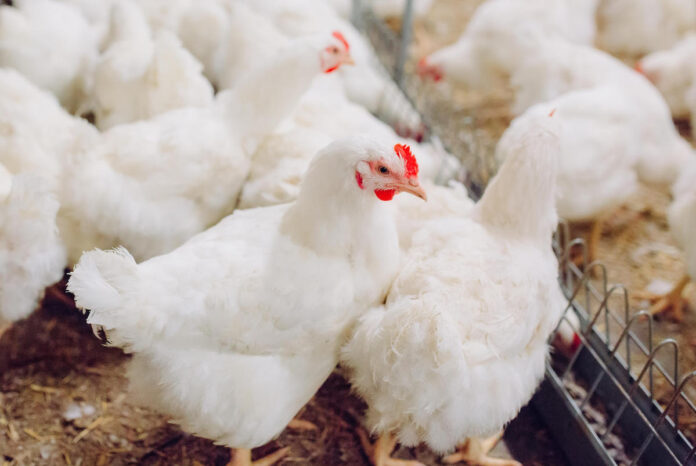
Broilers in-ovo or with post hatch photo-stimulation with green light (GL) were heavier from dark incubated birds. Furthermore, we defined the cellular and molecular events associated with the effect of in-ovo and post hatch GL photo-stimulation on muscle growth. We found that GL photo-stimulation have a stimulatory effect on proliferation and differentiation of satellite cells and a promoting effect on the uniformity of the muscle fibers in the early post hatch period. We gathered some evidence to support these findings; in-ovo GL photo-stimulation increased plasma growth hormone (GH) and prolactin (PRL) levels, as well as hypothalamic growth hormone releasing hormone (GHRH), and both the liver growth hormone receptors (GHR) and insulin-like growth factor-1 (IGF-1) gene expression. Both retinal and extra-retinal photoreceptors are active during embryogenesis and can be first detected at E14. We found that in-ovo green light photo-stimulated chicks have significantly higher retinal and hypothalamic green opsin mRNA gene expression levels compare to control. In contrast in-ovo blue light BL photo-stimulated chicks have significantly lower retinal and hypothalamic green opsin mRNA gene expression levels compare to dark control group. Many avian species are photoperiodic and respond to long photoperiods with an activation of reproductive axis. Photoreceptors were suggested to be involved in the detection of daily or seasonal changes in photoperiod. Photoreceptors are located in the eyes (retinal photoreceptors), pineal gland and hypothalamus (extraretinal photoreceptors). In birds subjected to a gonad stimulating photoperiod, long wave radiation (630-780 nm) penetrates the tissue and directly acts on hypothalamic extraretinal photoreceptors to stimulate reproductive function. In contrast to the stimulatory effect of long wave radiation on reproductive activity, activation of retinal photoreceptors by visible radiation by the green-yellow bands of the light spectrum (545-575 nm), appears to be inhibitory to reproduction. In a study conducted on female turkey and broiler breeders we found that extraretinal photo-stimulation combined with non-photo-stimulatory conditions to the retina caused a significant elevation in reproductive activity manifested by increase mRNA expression of hypothalamic GnRH-I pituitary LH and FSH, plasma LH and gonadal steroids, and increase in egg production.
The role of monochromatic light on growth of meat type birds
The effect of post hatch monochromatic photo-stimulation on growth and development of broilers
Broilers raised under blue or green fluorescent lamps gained significantly more weight than birds reared under red or white light, whereas feed conversion and mortality were not affected. There are, however, conflicting reports regarding the effect of monochromatic light on birds’ growth. Whereas green light (GL) was found to stimulate growth, mature female Japanese quail had lower body weight (BW) when reared under GL and blue light (BL) as compared to those reared under red (RL) or white light (WL). Turkeys grew better under BL until 16 wk of age but by 24 wk those reared under RL and WL were heavier. Pink light depressed chicken hatching weights with reversal by WL at 4 wk of age. The possible causes of contradictory findings were probably due to variability in light sources, methods of measuring light doses, species, breed, gender and age of experimental birds.
In order to eliminate some of these controversies, a light emitting diode (LED) was used for broiler photo-stimulation. LED is a pure monochromatic light source. Early studies conducted in our laboratory on broiler post hatch chicks have shown acceleration in growth rate in birds photo-stimulated by green and blue light during incubation, this acceleration in growth rate was also associated with increase in breast muscle weight. Green light enhanced growth rate significantly more than white and red light three days prior to hatch. Growth was also enhanced by blue light, but the onset of this effect was at an older age. These results were in agreement with Wabeck and Skoglund (1974), who demonstrated it in broilers, and Phogat et al., (1985) who found it in quails.
Chicks reared under green and blue light, by five days of age, had 2-2.4 times as much breast muscle satellite cells compared to white and red photo-stimulated chicks. Since satellite cells are members of myoblast family, any rise in their level may indicate stimulation of muscle growth, and a possible mechanism explaining the elevation in BW associated with green and blue monochromatic photo-stimulation.
The effect of in-ovo monochromatic photo-stimulation on growth and development of broilers
In commercial hatcheries, broiler eggs are set in the dark; however, several studies have shown that photo-stimulation accelerates embryonic development. In first study we investigated the effect of monochromatic green light on egg core temperatures. Photo-stimulation of broiler eggs with monochromatic green light caused a significant, time-dependent elevation in yolk temperature. Setting the eggs under an intermittent light regimen (15 min on, 15 min off) eliminated the rise in egg yolk temperature, and as a result, prevented early hatch associated with in-ovo photo-stimulation.
Green light photo-stimulation enhance embryonic BW, calculated as percentage of egg weight, and percentage of pectoralis muscle weight. The positive effect of light stimulation on muscle growth preceded its effect on BW in embryos and was evident on almost all days during incubation, suggesting a specific effect of green light on muscle growth.
At hatch (d 0), BW of the chicks did not significantly differ between the 2 in-ovo treated groups. However, during the first week post hatch, BW of chicks that were in-ovo photo-stimulated with green light was significantly higher than that of those hatched in the dark. The pectoralis muscle weight as percentage of BW of the chicks that hatched under green light was significantly higher than that of the chicks that hatched in the dark, both on hatching day and at 6 d of age.
What are the cellular and molecular basis underlying skeletal muscle developments in embryos and post hatch chicks in response to in-ovo green-light illumination? We found evidence for the mechanism behind the elevation in body weight and muscle growth associated to in-ovo green light photo-stimulation. The number of satellite cells per gram of muscle was higher in the green group compare to dark group.nA stimulatory effect of in-ovo green light illumination on muscle cell proliferation was further observed by immuno-histochemical staining for PCNA in muscle sections.
Expression levels of Pax7 and myogenin at early post hatch period are elevated by in-ovo green lighting. Our earlier findings that the percentage of pectoralis muscle of total body weight in in-ovo illuminated chicks is significantly higher than that in chicks incubated in the dark at all post hatch days analyzed (through day 42; 32), together with higher Pax7 levels (i.e., higher reservoir of quiescent/proliferative satellite cells), imply an enhanced hypertrophy potential of muscle because of in-ovo green-light illumination. We have shown a higher expression of growth hormone (GH) receptor mRNA in satellite cells derived from green light illuminated chicks.
Photoreception and stimulation of muscle growth in broilers
It is possible that the monochromatic green light penetrates the eggshell and has a direct effect on muscle in the embryo. Although short wavelengths are more likely to be effective at the dermal level, blue light has been found to penetrate the abdominal wall of rats to a depth 2 mm. However, we were unable to detect any proliferative effect of monochromatic green light on cultured myoblasts derived from standard (no illuminated) E17 embryos and 3-day-old chicks. A more likely explanation is that green light indirectly affects myoblast proliferation via the endocrine system; the latter receives photic cues from the retinal or extra retinal photoreceptors.
Recently we studied the expression of retinal and hypothalamic green opsin in related to in-ovo photo-stimulation with green, red and blue lights (Rozenboim unpublished data). Findings yielded from this study, shows that in-ovo green light photo-stimulated chicks have significantly higher retinal and hypothalamic green opsin mRNA gene expression levels compare to control. in-ovo blue light photo-stimulated chicks have significantly lower retinal and hypothalamic green opsin mRNA gene expression levels compare to control group. Post hatch green and blue light photo-stimulated elevated retinal and hypothalamic green opsin mRNA gene expression levels compared to control group.
Brain photoreceptors were not detected during late embryogenesis, suggesting that the enhancement of growth and muscle development in meat type birds might be governed by retinal photo-stimulation. Thorough and extended research is required in order to reveal the molecular mechanism by which the light affects the chicken’s genome, and the indirect way it influences its reproductive performances.
The role of monochromatic photo-stimulation of reproduction
Many avian species are photoperiodic and respond to long photoperiods by activating the reproductive axis. The neuroendocrine response to photo-stimulation is reflected by a significant release of GnRH- I, resulting in gonad recrudescence.
Photoreceptors have been suggested to be involved in the detection of daily or seasonal changes of photoperiod. It has been demonstrated that domestic fowl subjected to a gonad-stimulating photoperiod responded to the longer wavelengths of the spectrum. The sensitivity of the bird to long-wave radiation (630-780 nm) is a result of deep tissue penetration (hypothalamic extraretinal photoreceptors) stimulating the reproductive axis. In contrast, activation of retinal photoreceptors appears to be inhibitory to reproduction. The response to visible radiation is probably mediated by the green-yellow bands of the light spectrum (545-575 nm), where the avian retina is in relative peak sensitivity. We study the effect of retinal photo-stimulation by green light (14 h) while maintaining the extra-retinal photoreceptors in a non-photo-stimulatory condition by red light (6 h) and the effect of extra-retinal photo-stimulation by red light (14 h) while maintaining the retinal photoreceptors in a non-photo-stimulatory condition by green light (6 h) on reproduction of female turkeys and broiler breeders.
Our results indicate that extra-retinal photo-stimulation combined with non-photo-stimulatory conditions to the retina caused a significant elevation in reproductive activity of turkey and broiler breeder hens. This elevation was manifested by elevation in mRNA gene expression of hypothalamic GnRH-I, pituitary LH and FSH, reduction in hypothalamic VIP and pituitary prolactin mRNA gene expression, elevation in plasma LH and gonadal steroids, and significantly increase in egg production.
We investigated the mechanism behind the debilitating effect of retinal photo-stimulation with green illumination, by studying the involvement of serotonin and vasoactive intestinal peptide. We found that blocking the serotonergic axis by parachlorophenylalanine (PCPA) improved reproductive activities to the control illuminated group, however, active immunization of VIP did not improve reproduction. Collectively, the results suggest that retinal photo-stimulation inhibits the reproductive axis through serotonin and not through vasoactive intestinal peptide.
References are available on request
From the Proceedings of XXV World’s Poultry Congress

















